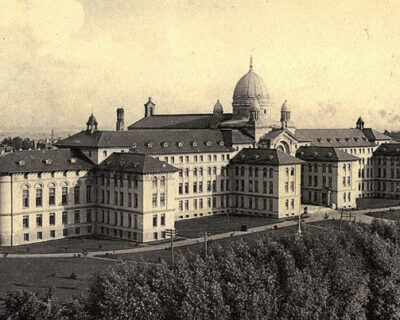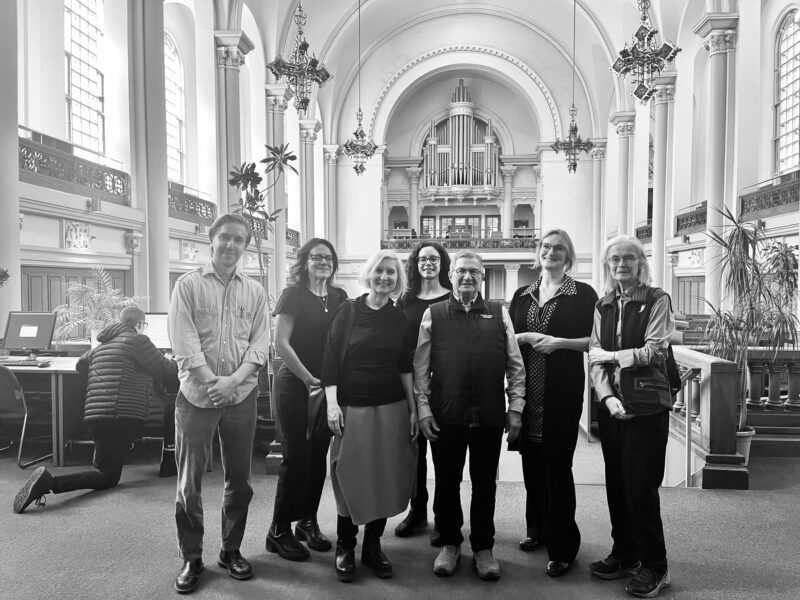Architect recalls transforming the motherhouse into Dawson
David Wigglesworth was never a teacher or staff member at Dawson but he worked here for 10 years.
David was the architect who oversaw the transformation of the Motherhouse of the Congrégation de Notre-Dame into Dawson College in the 1980s. On May 16, the Westmount Historical Association invited him to tell the story of this enormous project.
The meeting room at the Westmount Public Library was packed for the event and several Dawson employees and retirees were in attendance.
He went over the history of the congregation of sisters dedicated to education founded by Marguerite Bourgeoys and the building of this sixth motherhouse. The architect was Jean-Omer Marchand, the first Canadian graduate of the École des Beaux Arts in Paris. David shared that he chose a special yellow brick that was imported to stand out from the other buildings, which were grey. The statue of Mary and child on the dome is a replica of the Notre-Dame-de-la-Garde (Our Lady the Protector) statue in Marseille. The building was constructed between 1904-1908.
When the College took possession of the site, David recalled there was “ample evidence of care, a pervasive smell of floor wax and a depth of sheen to the floors.”
The natural light that came in through the large windows in the staircases was wonderful. Unfortunately, due to the fireproofing regulations, “we had to close them off.”
The conditions for Dawson’s renovations were that “all the trees had to be protected and the main entrance as well as the interior of the chapel.”

Undated photo of the motherhouse in the early days. Photo credit: CND Archives
Possible uses for the chapel
David revealed that they considered four other uses for the chapel before settling on the library: a cafeteria, a theatre, an agora, an exhibition space. He returned to Dawson a few months ago to prepare for his talk and was happy to see the space “functioning as designed: a quiet and calm environment for studying.”
“A new staircase had to be approved to connect the reading room (lower level) with the library level, the cruciform chandeliers were left, the brass railings and other items stayed. The CNDs kept their own works of art and new works were commissioned for Dawson’s library,” David said. The Cassavant organ was dismantled but its pipes are displayed, he said.
He confessed to having a fair share of disappointment in this transformation project, including closing in the staircases and not being able to save much of the original woodwork. “90-95 per cent of the interior was demolished and then we built additional wings in the south part of the yard and later on added gymnasiums and the engineering space,” he said.
“For an architect, the time of opening is a time of mixed emotions, dreams not fully realized,” David said. He was reassured by the CNDs who appreciated his work. “It continues to embody its vocation. Learning and teaching continues that was begun by Marguerite Bourgeoys,” he said. Dawson College opened at the motherhouse in 1988 and the full consolidation of the dozen campuses took place in 1997 when the Selby campus was closed.
Not much has changed
David joined the sisters on a few occasions for visits back to the college. Sometimes when he has visited past projects, he has been disappointed because they are hardly recognizable. When he returned to Dawson, “it was like walking into the building when we had first renovated it. It is unreal that Dawson looks so fresh and new.”
Claire Elliott, a librarian at the College, said that “the space has not changed.” The library had its first paint job in 30 years about a year ago. There are many needed updates that will require sources of funding in addition to the small amount that may be available from the Government of Quebec.
The transformation that came with the move
Simon Davies, a retired teacher in Cinema | Communications and New School, said it was a privilege to be part of the Facilities Planning Committee, which had about 25 faculty and staff members. He described the 8th floor, where New School is located, as being a “minimalist dormitory.” The move into the motherhouse from all those campuses was a major event, he said. Moving into the motherhouse, this one centralized location, transformed the identity of the college.
“When I joined the college, it was a pretty rugged school. People smoked in buildings,” he said. “This was such a transformation. The library became a central place for faculty and students. The librarians were incredible, and Facilities Management have to be commended for adapting to new needs. Everything functions so well. They are on top of the maintenance and cleaning but there is still not enough space. Dawson today is the number-one college with a great range of programs. There is so much pride in this place and it has been passed on. Thank you.”
Charlie O’Connor, a professional in Indigenous Peer Tutoring and Mentorship, said it was an interesting talk and raised a question about the religious artifacts, such as the stations of the cross, that have remained in the library.
David said he did not design the library; it was the staff of Dawson at the time who served on the committee. “We carried out the wishes of the committee,” he said.
Sarah Paltiel is the Director General who successfully negotiated the purchase of the Motherhouse from the Congrégation de Notre-Dame. “She went to great lengths to cajole and disturb the machinery of the Government of Quebec to get Dawson the motherhouse,” he said.
David shared his admiration for Dawson’s first female Director General: “She was the one who really supported the notion that if you build it well, and you build it in a way, which is to be proud of, then it will be looked after.”
The CEGEP is “occupying a space that is most difficult and yet they found a way to do it. With its narrow corridors, it’s a bit like trying to design in a train,” he said. “Somehow we didn’t get traffic jams and the students are happy to be there.”
When he came to visit Dawson on March 8, David shared why he thinks the library and Dawson are important for the anglophone community as well as the broader Quebec society:
“I think that any society that doesn’t have a library that’s an active part of their lives is missing something fundamental to their being. …A library provides a base of reference for anything that we’re studying, anything we’re learning, and anything we’re putting into it from what we’ve been learning. And it’s a teaching tool. It’s not just passive, it’s very active as well. Thank God, we still have libraries! It’s fascinating to go around and see how many students are just sitting there studying.” Some of those students, over the years, have included David’s children and grandchildren.
“My two granddaughters adore Dawson,” he said. One has graduated and is at Université de Montréal and the other is still a student at Dawson. At their bilingual home, David says they go back and forth between French and English, a tremendous advantage!
Featured image: David Wigglesworth, centre, with today’s librarians and Louise Carpentier from the Westmount Historical Association. Photo taken in March by Stephanie Ricci.



